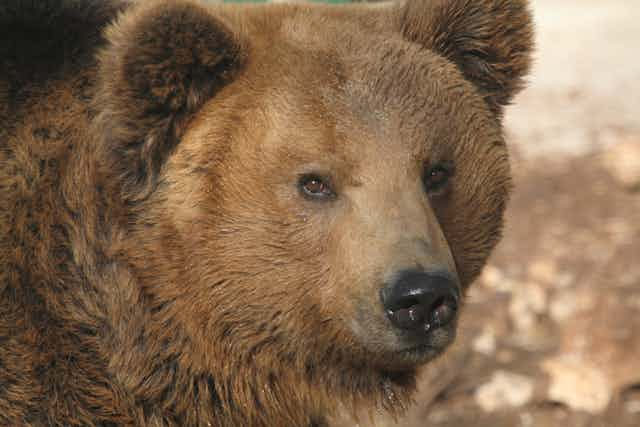It’s hard to believe that just a few hours drive from Rome, a small population of bears has survived in isolation for thousands of years. They live in the Apennine mountains that run along the centre of Italy, where high peaks merge into woodland, lakes and pasture, with humans scattered in villages throughout.
These are brown bears (Ursus arctos), the most common and widespread of the eight bear species. Brown bears can be found from the coldest coasts of Alaska to the relatively warmer mountains of Turkey, and right across Eurasia from Japan to Scandinavia.
With such a big geographical range, there are obviously some differences between certain groups. I specialise in skulls and skeletons, and have personally measured the huge skull of a Kodiak bear (estimated weight for that individual was 748 kg) – the largest brown bear of all, found in islands off Alaska – and the much smaller head of its relatives far inland.
Ecologists say these sorts of differences are adaptations to local diets and climate. Kodiak bears grew so big as they have no competitors for the islands’ abundant salmon, for instance, while bears at higher latitudes are also generally bigger in order to retain heat. These sorts of differences mean we can further divide the brown bear into subspecies – 14 at the last count – though scientists using molecular data are constantly challenging this number.
In 1921, an Italian surgeon and amateur zoologist, Giuseppe Altobello, identified some peculiar traits in a population of brown bears from the Apennines: the Marsican bear (Ursus arctos Marsicanus) also known as the Apennine brown bear.
Through the years, the Marsican bear became the symbol of the local Abruzzo National Park and lent its name to pan dell'orso (bear bread) and other traditional regional foods. Thanks to its presence, ecotourism improved in the whole Abruzzi region, though conflicts with shepherds and honey farmers are still reported. In prehistoric times, hundreds of bears would have lived in these mountains. Today, the latest population estimate is around 51.
The small – though stable – numbers of Marsican bears give rise to an important conservation question: how much of a species should we preserve? According to the IUCN the brown bear is classified as “Least Concern”, which is to say that it does not require urgent conservation actions. But that is the species as a whole. What about each subspecies?
The Marsican bear is still completely isolated from its nearest neighbours, a population of Eurasian brown bears in the Italian Alps. It could expand its range though, as there is suitable habitat throughout the Apennines.
Colleagues and I wanted to investigate what made the Apennine bear different from other brown bears. In particular, our study focused on its peculiar mandible (lower jaw) which has a thick portion below the teeth to generate the power needed to crunch through the nuts the bears like to eat in autumn. This isn’t the only example of a brown bear subspecies adapting its jaw to its environment – in the Tibetan plateau, another isolated population, the Isabelline bear, has evolved unique slender mandibles in order to catch burrowing rodents.

The Marsican bear appears to have changed relatively quickly, at least on the sorts of geological timescales over which evolution usually occurs. Given there is no fossil evidence of ancient Marsican bears, its distinctive jaw appears to have developed only in the past 600 years or so, if genetic estimates are correct.

The change could have been down to the climate, but our data did not support this. Instead, ancient DNA points to the existence of one massive European population of brown bears with high genetic flow from country to country. At this time, bears would have been fairly similar across all of the continents. But after the most recent ice age ended and the Holocene began – and humans and their habitat changes cut off bear populations from one another. At the point in relatively recent history when bears in the Apennines were no longer able to breed with the wider brown bear population, they began to evolve their unique jaws.
Bears are making a comeback across Europe as a whole. One study reported a happy 17,000 brown bears living and re-colonising all over the continent. Within this context, what is the future of the unique isolated Apennine bear?
Initiatives promoted by Rewilding Europe and local groups are providing more pragmatic solutions to prevent increasing human-bear conflict – in 2007 three Marsican bears died due to eating poisoned carcasses. Since then seven individuals are reported to have died of natural causes, which given the small size of the population is also of concern.
On the positive side, a more recent census identified six reproductive females in the Apennine central range of Marsican bear with an estimate of ten pups produced during 2016. It’s now up to us to provide a brighter future for this new generation.

